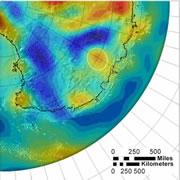 A dense bit of rock in the Antarctic (orange circle) seems to be circled by a crater.© Ohio State University
A dense bit of rock in the Antarctic (orange circle) seems to be circled by a crater.© Ohio State UniversityEvidence of a cataclysmic meteorite impact has been unearthed in Antarctica, according to researchers who say the collision could possibly explain the greatest mass extinction ever seen on our planet. But scientists contacted by news@nature.com say they are sceptical, as no signs of such an enormous impact have been found in other, well-studied areas of Antarctica.
The first sign of this possible impact was spotted by NASA's GRACE satellites, a pair of orbiting probes that sense slight variations in the Earth's gravity field. They revealed a 320-kilometre-wide plug of dense mantle material more than 1.6 kilometres beneath the East Antarctic ice sheet in an area known as Wilkes Land.
This mass concentration, or 'mascon', can be caused by the upwelling of denser material from the Earth's mantle after a massive impact. "If I saw this mascon signal on the Moon, I'd expect to see a crater around it," says Ralph von Frese, a geophysicist at Ohio State University, Columbus, who led the team that made the find.
When they looked at airborne radar images of the area, they found what they say looks like a crater — a circular ridge some 500 kilometres wide running around the mascon. "It could be the biggest impact ever found on Earth," says von Frese.
Incoming!
"It's possible, but it's not the interpretation that would top your list," says Ian Dalziel, a geologist at the University of Texas at Austin. The region of dense rock is certainly circular, he says, but it could easily be volcanic rock that had welled up during normal geological activity: "You can find a lot of gravity anomalies like this." The roughly circular feature thought to be the rim of the crater may just be part of the normal variation in terrain in the area, he adds.
If an incoming asteroid did gouge out the hole it must have been up to 50 kilometres across, says von Frese. That's four or five times larger than the object thought to have created the Chicxulub crater on the Yucatan peninsula in Mexico, which was probably responsible for wiping out the dinosaurs some 65 million years ago.
But that's peanuts compared with the Permian-Triassic extinction, which destroyed more than three-quarters of all species on Earth about 250 million years ago. The cause of this mass extinction is still hotly debated by scientists.
Most think that the extinction started when a vast volcanic eruption released a flood of lava to create the Siberian Traps — an area of basalt that covers an area larger than Europe. "They represent the biggest volcanic event of all time, and coincide precisely with the extinction," says Paul Wignall, a palaeontologist at the University of Leeds, UK, who studies mass-extinction events. Such an eruption would have belched huge amounts of gas, including sulphur dioxide and carbon dioxide, into the atmosphere, causing acid rain and greenhouse warming.
Other scientists have argued that a massive impact, like that at Chicxulub, could be responsible instead (see '"Comet impact theory faces repeat analysis": http://www.nature.com/news/2004/041025/full/4311027a.html'). "But nobody's been convinced of that," says Wignall.
Von Frese notes that the explanations aren't mutually exclusive: the shockwaves from a huge impact could have travelled through the planet to trigger the eruptions in Siberia, delivering a devastating combination of disasters.
Hot topic
Von Frese presented the discovery at an American Geophysical Union meeting in Baltimore, Maryland in late May. He admits that it was greeted with "a lot of scepticism", largely because there's no direct evidence that the feature is 250 million years old.
ADVERTISEMENT
An impact of that size should also have melted and twisted nearby rock. Yet rocks in the Transantarctic Mountains of the same age show no evidence of the collision, says Jane Francis, a geologist also at the University of Leeds. "That sequence has been worked on before, and no one has found evidence to support a massive impact like this," she says.
Wignall says that few scientists will be convinced by the hypothesis until the team can precisely date their crater directly, and find rocks there that have been altered by the searing heat of the explosion. "Then we'll all sit up and take notice," he says.
Too much ice covers the putative crater for a drilling expedition. But Von Frese hopes to make a research trip to Antarctica to look for rocks at the base of the ice sheet along the continent's coast that could attest to an impact.
Visit our agiantcraterlie_beneat.html">newsblog to read and post comments about this story.
